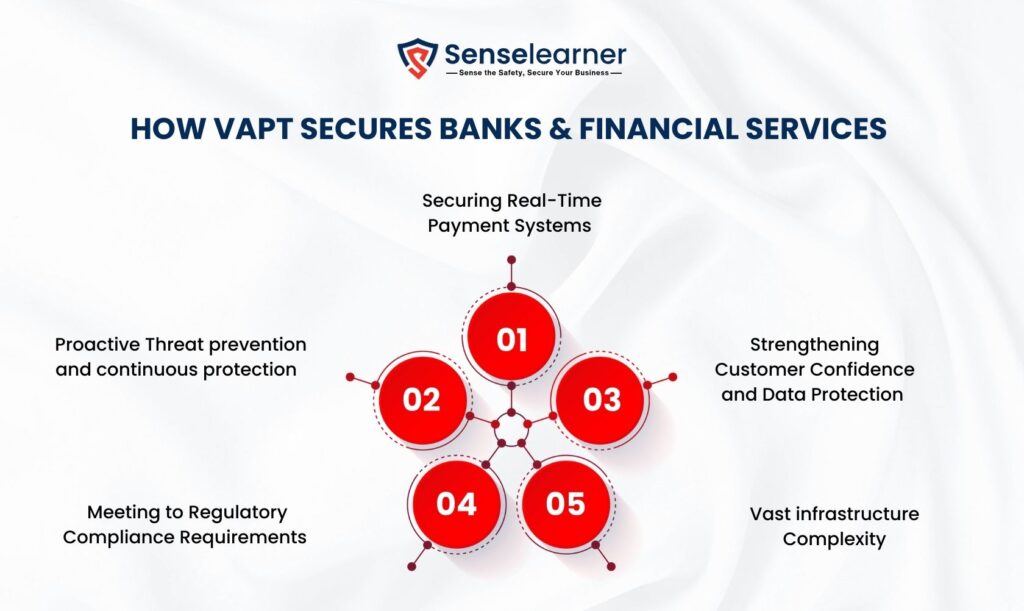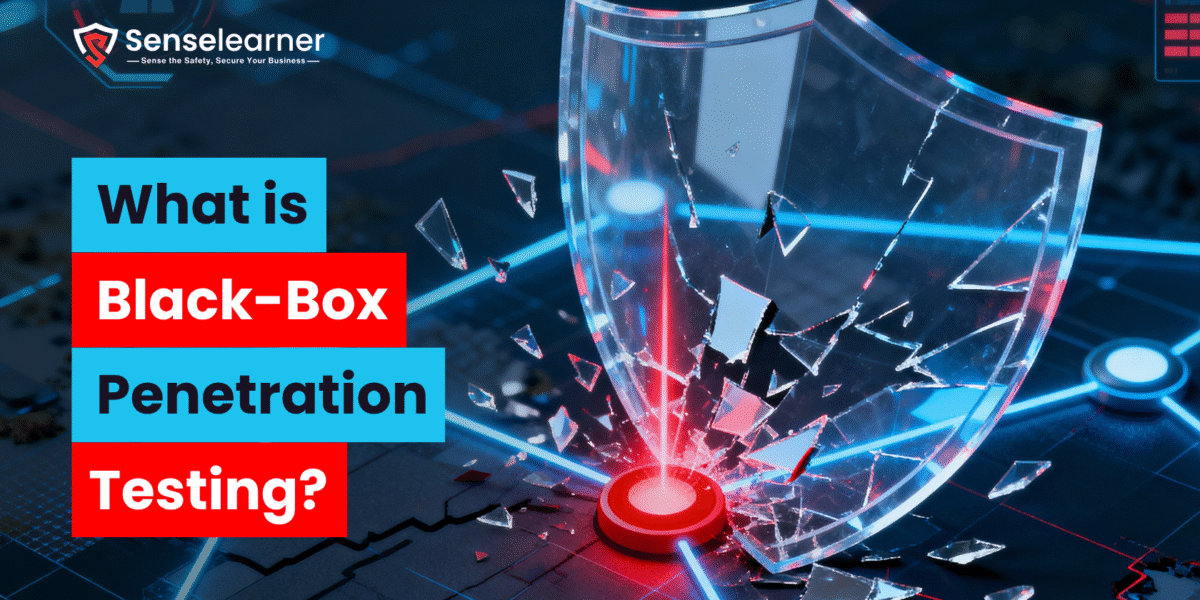Table of Contents
“Why VAPT is crucial for Banks & Financial Services.” This article examines challenges to VAPT implementation within the financial sector, such as intricate IT infrastructures and strict compliance requirements. Following that, it emphasizes the primary advantages—preventing threats proactively, meeting regulatory obligations, fostering customer trust, and safeguarding real-time payment systems. The article also explains why payment systems are attractive targets for cyberattacks, provides real-world examples illustrating the effectiveness of VAPT, and wraps up by discussing how Senselearner’s comprehensive security strategy can shield financial institutions from emerging threats.
What is VAPT?
Vulnerability Assessment and Penetration Testing (VAPT) is a comprehensive cybersecurity procedure that uncovers, assesses, and addresses security flaws in an organization’s systems and applications. It merges two related methods: Vulnerability Assessment and Penetration Testing.
(VAPT) is a cybersecurity approach that integrates two essential techniques to identify and address security vulnerabilities. A vulnerability assessment serves as an automated, high-level evaluation to a digital health examination, utilizing specific tools to passively discover known issues such as outdated software or misconfigurations, ultimately providing a prioritized outline of concerns. On the other hand, a penetration test involves an active, simulated cyber-attack conducted by a certified ethical hacker who exploits the identified vulnerabilities, assessing whether a genuine attacker could infiltrate the system, access confidential information, or disrupt services. The complementary nature of these two techniques offers a precise, actionable strategy for bolstering defenses: the extensive scan uncovers potential vulnerabilities, while the focused attack confirms the most critical issues, illustrating their real-world implications and delivering a thorough perspective on an organization’s security status.
Main Challenges of VAPT in the Finance Industry

VAPT in the financial industry encounters obstacles because of its distinct features. The intricate and frequently interlinked structure of contemporary banking systems, along with the continuous demand for operational availability, poses a challenge that is not encountered by other industries.
Managing the complicated web of regulatory and compliance obligations.
Unlike other sectors, financial organizations function on extensive, interlinked systems that incorporate a combination of outdated legacy platforms, contemporary cloud solutions, and multiple third-party integrations. This complexity complicates the definition of a thorough VAPT scope, creating a risk that testing could overlook essential vulnerabilities in older systems or newly developed APIs.
The complexity of the IT landscape and the necessity for ongoing operations.
Another significant difficulty lies in managing the complex array of regulatory and compliance obligations. While regulatory bodies require VAPT, each authority, such as the RBI or PCI DSS, has its own particular and frequently stringent criteria regarding the execution and documentation of tests. Financial institutions must ensure their VAPT approach not only detects threats but also produces reports that are ready for auditing and comply with these rigorous standards. This imposes additional administrative demands and technical challenges, as the VAPT service provider must possess extensive knowledge of these regulations to guarantee that the evaluation is both effective and compliant.
Also Read What is Encryption? and How does it work
How VAPT secures Banks & Financial Services

1. Proactive Threat prevention and continuous protection
Rather than waiting for a cyber attack to occur, VAPT enables banks and fintech companies to stay ahead of potential threats. By systematically performing vulnerability assessments, they can identify and fix security weaknesses before they can be exploited by malicious actors. The penetration testing then simulates real-life attacks, uncovering how various vulnerabilities could be combined to create a substantial breach. This proactive approach, especially when conducted annually or following significant system modifications, guarantees continuous defense against an ever-evolving threat landscape. This process reduces the likelihood of expensive downtime and financial losses
2. Strengthening Customer Confidence and Data Protection
In the financial industry, gaining customer trust is crucial. VAPT plays a vital role in this by showcasing a strong dedication to data protection. When clients are aware that their sensitive financial and personal information is being safeguarded through thorough security evaluations, it builds confidence in the institution. By averting serious data breaches, VAPT not only protects the organization’s reputation but also the financial interests of its clients, which serves as a significant competitive advantage
3. Meeting to Regulatory Compliance Requirements
The financial services sector is one of the most strictly regulated industries, with rigorous cybersecurity requirements set by organizations such as the Reserve Bank of India (RBI) and international standards like PCI DSS. Regular VAPT is frequently a compulsory stipulation for achieving compliance with these standards. By delivering comprehensive, actionable reports, VAPT assists financial institutions in demonstrating that they are proactively evaluating and addressing risks. This not only helps avoid substantial fines and legal repercussions but also ensures that the institution maintains a robust, audit-ready security framework.
4. Securing Real-Time Payment Systems
VAPT offers thorough vulnerability identification, uncovering flaws at all levels, including network setups, insecure API endpoints, and improperly configured payment gateways. By mimicking actual cyber attacks, VAPT enables organizations to evaluate the security of their payment gateways and strengthen them against prevalent attack methods such as SQL injection and cross-site scripting (XSS). Additionally, VAPT improves transaction integrity by replicating man-in-the-middle attacks to verify end-to-end encryption and secure data transfer. Finally, VAPT conducts API security assessments, ensuring that authentication processes, data management, and access controls are sufficiently robust to reduce the likelihood of exploitation, thus protecting the digital foundation of real-time transactions.
Continue Reading Proton Mail Review: Is it the most secure Mail?
Why Real Time Payment systems are a Target
API Vulnerabilities: The connections between banks, applications, and third-party services for real-time payments may contain security flaws. Attackers can take advantage of these vulnerabilities to perform unauthorized transactions, capture sensitive information, and manipulate the financial processes, circumventing typical security measures.
Evolved Scams and Phishing: The urgency of these payments makes them ideal for fraudulent activities. Scammers employ social engineering and phishing tactics to deceive users into approving payments to a criminal’s account, a form of “Authorized Push Payment (APP) fraud” that is nearly impossible to reverse.
Ransomware and Malware Attacks: Cybercriminals use malware and ransomware to breach financial systems. A successful breach can severely hinder a bank’s ability to handle payments, leading to significant operational disruption, financial losses, and a total erosion of customer trust.
Real World Scenarios where VAPT helps
Assist in Preventing Fraudulent Transactions
When a financial technology platform notices unusual activity spikes, Vulnerability Assessment and Penetration Testing (VAPT) can be utilized for investigation. It identifies insecure API endpoints that fraudsters might exploit to carry out unauthorized fund transfers, allowing the organization to address these vulnerabilities and avert significant financial losses.
Enhancing Security for Mobile Payment Applications
VAPT serves to proactively secure mobile wallets and banking applications. For instance, a penetration test could expose a significant flaw that enables an attacker to circumvent authentication measures, providing the company with the chance to resolve the issue and avert a data breach before it affects any customers.
Protects against Insider Threats
VAPT assists organizations in safeguarding against both intentional and unintentional insider threats. It can reveal misconfigured permissions within a payment system, allowing the company to restrict employee access to sensitive information and essential systems, thus minimizing the risk of internal compromises.
How can Senselearner help?
Our team offers a multi-layered strategy to safeguard your organization’s digital assets. With our Proactive and Ongoing Managed Threat Hunting, we investigate potential threats and unusual activities that could evade conventional security measures, neutralizing them prior to any breach. We enhance this approach with our Managed Vulnerability Scanning Service, which conducts continuous, automated assessments to uncover security flaws and misconfigurations within your systems. By merging these two proactive services, we not only respond to threats but actively seek them out and address the fundamental vulnerabilities, ensuring that you stay ahead of the constantly shifting cyber threat landscape and maintain a robust security posture.
FAQ’s
Q1. In what ways does VAPT tackle the specific risks associated with real-time payment systems in banks?
VAPT uncovers vulnerabilities in APIs, payment gateways, and transaction processes. By mimicking attacks such as man-in-the-middle, SQL injection, or bypassing authentication, it safeguards the integrity of instant payments and helps avert fraud or unauthorized access.
Q2. What difficulties do financial institutions encounter when trying to implement VAPT successfully?
Banks frequently face challenges with legacy systems, interconnected third-party services, and stringent uptime demands. These issues complicate the process of defining VAPT scope without disrupting business activities and necessitate highly specialized testing that aligns with RBI and PCI DSS standards.
In what way does VAPT enhance regulatory audits beyond mere compliance checklists?
Unlike standard security assessments, VAPT yields actionable risk insights and proof-of-exploit evidence. This enables banks not only to verify compliance but also to provide regulators with documentation of proactive defense measures and preparedness for incidents.
Can VAPT help mitigate insider threats in financial institutions?
Absolutely. By conducting configuration reviews and privilege escalation assessments, VAPT can identify poorly managed access rights or vulnerabilities within the organization. This diminishes the chances of intentional misuse or accidental data exposure by staff, which represents a crucial yet frequently neglected security threat in banking.
Conclusion
In summary, VAPT is more than just a regulatory requirement for the financial services sector; it is a critical and proactive approach to security. Considering the ever-changing nature of cyber threats and the valuable data involved, conducting regular VAPT is crucial for detecting and addressing vulnerabilities before they can be taken advantage of. By integrating thorough vulnerability assessments with practical penetration testing, banks and fintech companies can establish a strong defense, maintain customer confidence, and protect the integrity of their real-time payment systems, thus preserving their reputation and financial health in a progressively perilous digital environment.



